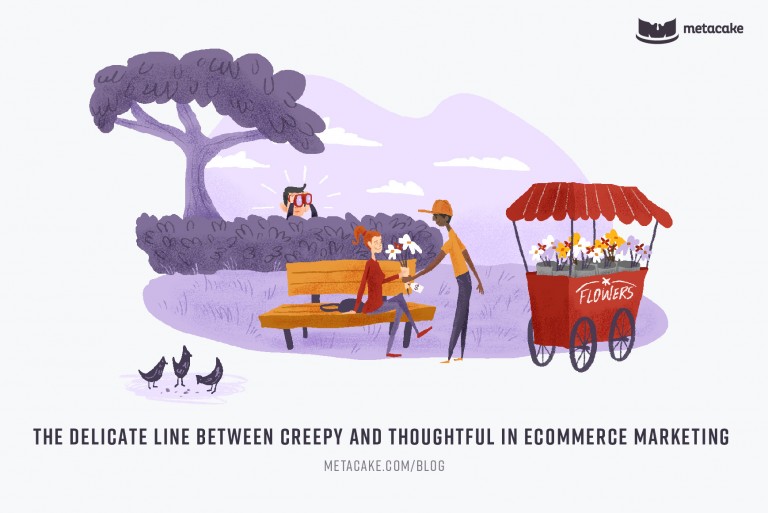The world of ecommerce has changed marketing quite a bit. With ever improving technologies and seemingly endless customer data, marketers can be extremely specific and intentional. Truly personalized marketing is certainly possible at scale, and it can also be abused to the point of stalking your customers all over the internet. This results in higher ad costs and burnt out customers.
With the data and technology available to us, we can really overstep our bounds and damage our relationship with our customers, rather than strengthen it. Leaving your customers wondering if their iPhone is listening to them is not conducive to building trust.
In this guide, we’re going to provide 4 guidelines for your marketing team to keep in mind as they’re managing your paid ads and email campaigns. When done right, it’s a win-win for everyone.
4 Guidelines For Marketing Ecommerce Products
1. Use data wisely
We have more targeting and behavioral data than ever available to us, but just because you have it doesn’t mean you should use it all. Practice control. While people are used to being served ads based on their interests, you should still respect their personal space. Just because you know the last 12 products they viewed on your store, doesn’t mean you should text them about them at midnight.
2. Don’t skip relational levels
When you meet someone for the first time, you don’t ask them to babysit your kids. In the same way, when a potential customer interacts with your brand, follow up with in ways that build a relationship and don’t violate their space.
This means that you must be more sophisticated in your use of the tools that you have. It’s actually harder to be more thoughtful. It’s much easier to just harass people, unfortunately.
Rather than beating people with retargeting ads and videos, create ad funnels and email sequences that nurture someone over time.
3. Let them go!
There is nothing more annoying than bugging someone to do something and then continuing to bug them even after they do what you asked. Once someone takes action, stop asking them to take that action. This is harder than you think, which is why so many brands aren’t using this level of sophistication.
With the tools we have at our disposal, we have the ability to transition someone into a different phase of communication after they take the action we are trying to get them to take, but you have to be aware of that and make it happen. It doesn’t just happen on its own..
4. Be a master of the tools
With all the information and power at your disposal as a brand, you have the ability to create amazing success, or the whole thing can just blow up in your face. Ad costs through the roof, and users who are burnt out.
To do this right you must become a master of the platforms and tools. This may not be you, especially if you’re an owner or executive of a brand. If that’s the case, take the time to hire specialists who are masters at the platforms so that you can use all this power to deliver amazing customer experiences
And if you are in need of an expert team that does this for some of the world’s most influential brands – reach out!
Get your other systems in order.
Data Integration
For a long time now, we have been able to track almost every behavior on a website. But getting this data to talk to your various marketing platforms was next to impossible. Now, data integration between your marketing platforms and ecommerce platform have become more readily available.
Our favorite combo is Shopify Plus with Klaviyo’s email marketing platform. The data integration is seamless, so you can see the performance of your email campaigns in terms of dollars and cents in real-time, as well as use data dynamically in your emails. Whether creating targeted segments for personalized marketing or using customer variables in the body of your emails, the Klaviyo and Shopify Plus combo makes it easy to dynamically send messages to your audience to build your relationship with them.
Automations
Automations, such as email sequences and marketing funnels, make the integration of marketing and ecommerce data even more powerful. Sequences can be automatically triggered and will dynamically update based on customer behavior on your site. This is a great way to scale your personalized marketing.
So, how do we walk the line in personalized marketing?
Personalized marketing is becoming easier to accomplish. But just how personal should you get?
There is no hard and fast rule here, and it largely depends on your audience. The younger generations are much more accustomed to personalized marketing and therefore less likely to get creeped out.
Use common sense and treat your relationship with your customers as you would any other normal relationship. If you just met someone, you shouldn’t email them every day with personal messages calling out what products they’ve viewed on your site or the exact date and time of their last visit.
Utilize the data you have for targeting. By all means, include products customers have added to cart or viewed several times on your site in retargeting ads or abandoned cart emails. But don’t call out every product they viewed or follow them all over the internet. Give your customer space and respect their boundaries. Aim to be helpful, reminding them of products they have expressed interest in to bring them back to your site, but don’t be overbearing or annoying.
